August 13, 2003
A red sky in the morning and a red sky at night
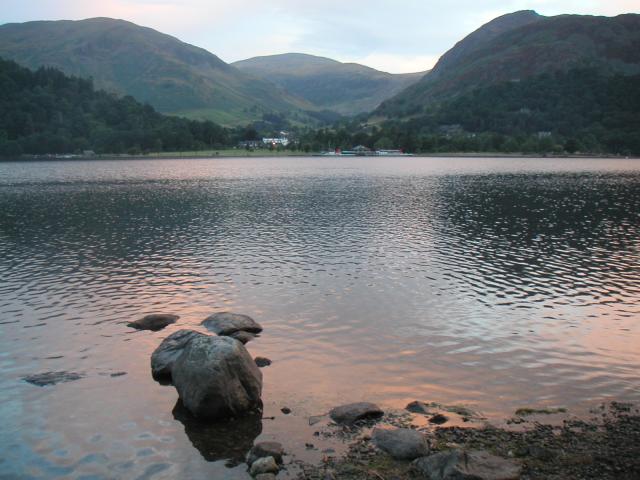 This is a view across Ullswater in the English Lake District, from Side Farm campsite towards Glenridding. The water reflects the bright pink colour of low clouds lit from below by the rising sun.
This is a view across Ullswater in the English Lake District, from Side Farm campsite towards Glenridding. The water reflects the bright pink colour of low clouds lit from below by the rising sun.
I am not usually awake before dawn, let alone up, dressed and out admiring the view. The ground at Side Farm is hard, the rock under my hip bone harder, and getting up for an early morning stroll preferable to lying awake on both. As I watched the progress of dawn, a flockof geese flew by, landing noisily in the water a hundred metres north. More serenely, a family of swans, a male, a female and six cygnets swam warily past.
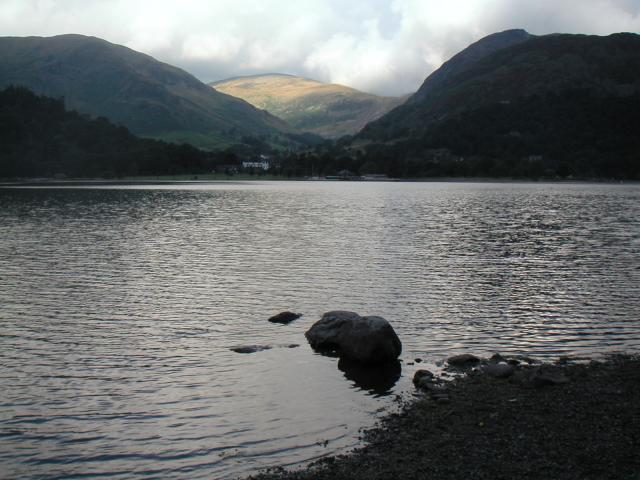 As the sun rises it must clear the hills to the east before warming the ground below. First it lights the distant hills to the west, and as the minutes pass, the shadow shrinks and the terminator creeps down the hillside to the opposite shore, lighting the steamers in their berths before setting out across the lake, until, at around nine o'clock, starting to dry the dew condensed on our tent.
As the sun rises it must clear the hills to the east before warming the ground below. First it lights the distant hills to the west, and as the minutes pass, the shadow shrinks and the terminator creeps down the hillside to the opposite shore, lighting the steamers in their berths before setting out across the lake, until, at around nine o'clock, starting to dry the dew condensed on our tent.
I love the Lake District. Camping there is the best holiday; the fastest way I know to relax. Every little action in camp requires care; a wrong move can have lasting effects on comfort. A wrong word to one's companions can have a similar effect. There are few plans to make, few goals to attain and few uncertainties all of which lead, with the help of good equipment, good food and good wine to rest.
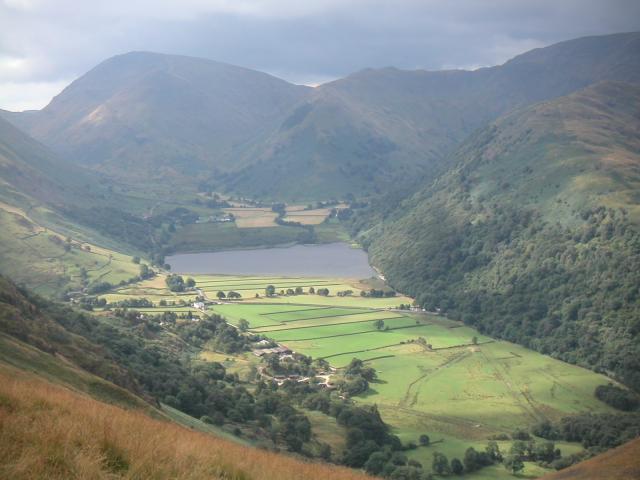 After breakfast, Janet, Ian and I set out up the hill to the east over which the morning sun has recently appeared to walk to Angle tarn. The hillside is steep and before long we enjoy the view south over Brother's Water to the Kirkstone Pass. The day is cloudy with gaps through which the sun lights up segments of the landscape. In this image, the hills are in shadow and the green fertile fields of the valley floor highlighted.
After breakfast, Janet, Ian and I set out up the hill to the east over which the morning sun has recently appeared to walk to Angle tarn. The hillside is steep and before long we enjoy the view south over Brother's Water to the Kirkstone Pass. The day is cloudy with gaps through which the sun lights up segments of the landscape. In this image, the hills are in shadow and the green fertile fields of the valley floor highlighted.
The hills and valleys of this region were formed by glaciation. The U-shaped valley typically formed by a glacier can be clearly seen. The flatness of the fields suggest that this land was once beneath the surface of a lake. The fields are flat because they were once silt on the lake bed. The lake has shrunk and untill all that remains is Brother's Water. I wondered if it will survive global warming and speculated about writing a story set after the Lake District has dried up. "Mummy, Mummy, why do they call this the Lake District?"
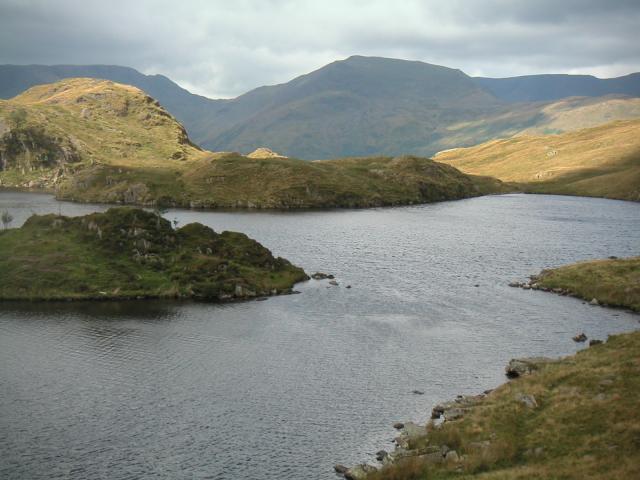 After a bit more than an hour of gentle trudging we reach Angle Tarn, where we stop to redistribute the weight from the rucksack Ian carries. We move the crisps (for salt), sandwiches, fruit and drink from his pack to our stomachs. Janet had started out carrying the pack, but as we climbed the hillside Ian took over as she found walking uphill more demanding than walking on the flat.
After a bit more than an hour of gentle trudging we reach Angle Tarn, where we stop to redistribute the weight from the rucksack Ian carries. We move the crisps (for salt), sandwiches, fruit and drink from his pack to our stomachs. Janet had started out carrying the pack, but as we climbed the hillside Ian took over as she found walking uphill more demanding than walking on the flat.
We had set out not sure how far we wanted to walk. We could have turned round after lunch, which we would do when we repeated this walk two days later, but on this day, walking back the way we came looked too boring and I had spotted a route, continuing to just below a hill called the Knot, down the hillside to Brother's Water and then back up the valley floor to our campsite. So off we set for the Knot.
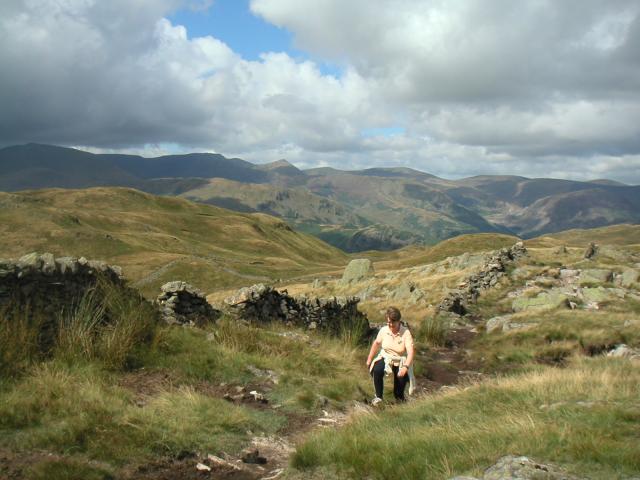 The going was flat and pretty easy. The clouds thinned, the sun shone and we enjoyed the beauty of the landscape as we walked on. I had three cameras with me. The small Minolta digital camera that took the pictures on this page, my old Olympus XA point and shoot film camera with its marvelous 35mm lens loaded with slide film and a medium format camera and tripod carried in a heavy backpack. That backpack was my burden and was, I think, the main reason I did not put on much weight on this trip despite the good eating and plentiful drinking we did in the evening. Several times, I took the same photograph with each camera to compare their effectiveness. Is it really worth carrying the weight of the medium format camera? I am contemplating buying a new scanner which can scan negatives upto 5 inches by four inches, which will temp me to get a field camera.
The going was flat and pretty easy. The clouds thinned, the sun shone and we enjoyed the beauty of the landscape as we walked on. I had three cameras with me. The small Minolta digital camera that took the pictures on this page, my old Olympus XA point and shoot film camera with its marvelous 35mm lens loaded with slide film and a medium format camera and tripod carried in a heavy backpack. That backpack was my burden and was, I think, the main reason I did not put on much weight on this trip despite the good eating and plentiful drinking we did in the evening. Several times, I took the same photograph with each camera to compare their effectiveness. Is it really worth carrying the weight of the medium format camera? I am contemplating buying a new scanner which can scan negatives upto 5 inches by four inches, which will temp me to get a field camera.
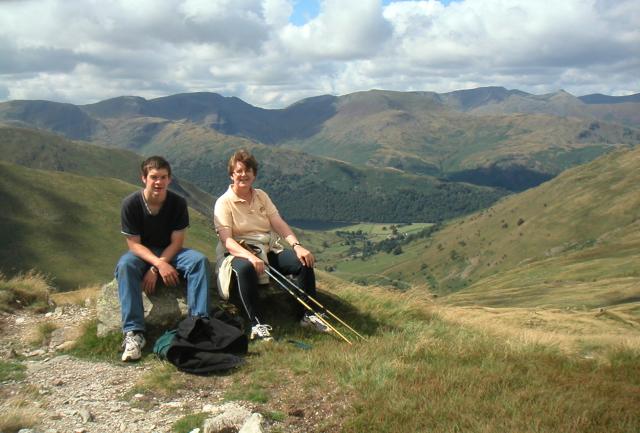 We walked on reaching the Knot where we rested and drank the rest of the water, after about another hour. The sun was shining strongly. We turned down the hill towards the valley where I was reminded that going down hill can be harder than going up. The going was steep and my knees were trembling and wobbly by the time we got to the bottom.
We walked on reaching the Knot where we rested and drank the rest of the water, after about another hour. The sun was shining strongly. We turned down the hill towards the valley where I was reminded that going down hill can be harder than going up. The going was steep and my knees were trembling and wobbly by the time we got to the bottom.
By the time we reached the bottom, I was tired and ready to stop, but we still had 3 to 4 kilometres to walk back up the valley floor. By now, the clouds had more or less disappeared; it was very hot in the valley floor and we faced a dilemma. We could walk up the main road which would take us first to the pub in Patterdale and I really fancied a cold beer (or two). Alternatively we could take a nearly parallel track which, being away from the traffic is safer and is a very little shorter. We took the track, and when we eventually got back to Side Farm we stopped at the tea shop and had tea and ice cream. Though highly desirable, the cold beer was just too far away.
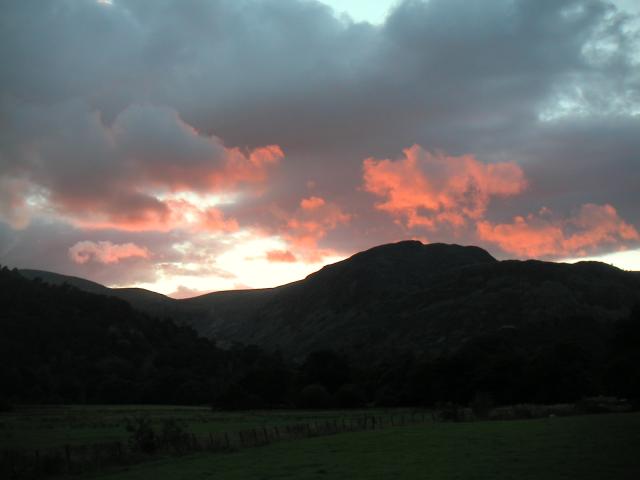 After a rest we had trouble with the stove (easily fixed the next day with some WD40) and went to the pub for supper (an experience I wouldn't recommend - try the Patterdale hotel.) After a meal and a bottle of wine, the sun had already set as we walked slowly back to the campsite. As we walked, I noticed that the set sun had turned the clouds a similar shade of deep pink as it had at dawn.
After a rest we had trouble with the stove (easily fixed the next day with some WD40) and went to the pub for supper (an experience I wouldn't recommend - try the Patterdale hotel.) After a meal and a bottle of wine, the sun had already set as we walked slowly back to the campsite. As we walked, I noticed that the set sun had turned the clouds a similar shade of deep pink as it had at dawn.